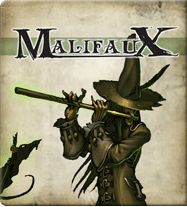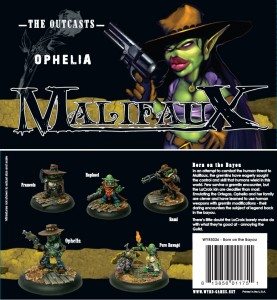
Reecius finally manages to get a game of Malifaux in and gives his first impressions.
So, I finally got to play Malifaux in a real game. We have been so busy at the shop with the Bay Area Open, painting commissions, and the general running of a game store, that I have had very little time to play lately.
I have been wanting to get a game of Malifaux in, and finally had the chance with one of the game’s designers no less!

I played the La’Croix Gremlin family crew, as I love the models. My opponent played the “Zombie Hooker” Resurrectionist crew. Hillbilly Gremlins vs. Zombie Hookers. If you aren’t already intrigued by the name alone, then we may not be on the same page!
This is going to be a brief rundown of my first impressions of the game, not an in depth analysis as I don’t know the system well enough yet to really provide that.
The basics of the game are that it is a skirmish level fantasy/Gothic horror/steam punk style setting in which you use small “crews” of miniatures, each with a slew of special rules and statistics. The skill of the game comes in seeing how to use each unit’s special rules to pull of combinations and maneuvers that will set up game winning moves.
Instead of dice, you use a deck of cards to determine the results of attempted actions. I like this a lot as for one, it gives a larger range of variability, and it gives you a greater degree of control over the outcome of an action as you hold a deck of cards you can use to modify actions (as well as a number of other ways to “cheat” fate and influence what happens). I like this mechanic a lot as it allows skill to overcome chance more so than in 40K (or a similar game). You can essentially mitigate bad luck by managing your resources wisely.
The game plays in an alternate unit activation format, unlike 40K. Each player draws a card to determine who activates first, and then takes turns using a single model. The other player then does the same until all models have been activated and then the turn starts over.
The game is much more complex than that, but for now, that is what you need to know to understand the basics.
We played through a complete game, and it was a blast! I really, really enjoyed myself. The game is a lot more complex than 40K, with lots of variables occurring at once, rules to understand about your and your opponent’s units, and resources to manage. This is a thinking man’s game, no doubt, and I appreciate complexity in a rules system when done right, and so far, Malifaux seems to do it right for me.
Our game was quite fun. My little Gremlins pack a mean punch while my opponent’s Zombie Street Samurais and Hookers were tough to kill. It looked like curtains for me when his main character managed to destroy my Dynamite pig (and yes, that is a pig with dynamite strapped to it!) while it was close to my units and nearly wiped me out!
I managed to fight my way back into the game though, by using special rules and combos to activate my entire crew in the same activation. My last model with one wound and shot remaining managed to kill my opponent’s last model. It was a great way to end a fun game.
I will dig further into the guts of the rule system after getting a few more games in, but my initial reaction is very positive. The game is fun, complex enough to allow for deep tactics, and cheap! A crew is only about $30-$40 and the rules books are inexpensive as well. You can easily get into the game for under $50.
We will have more coverage of Malifaux as we learn the game and play it further.
